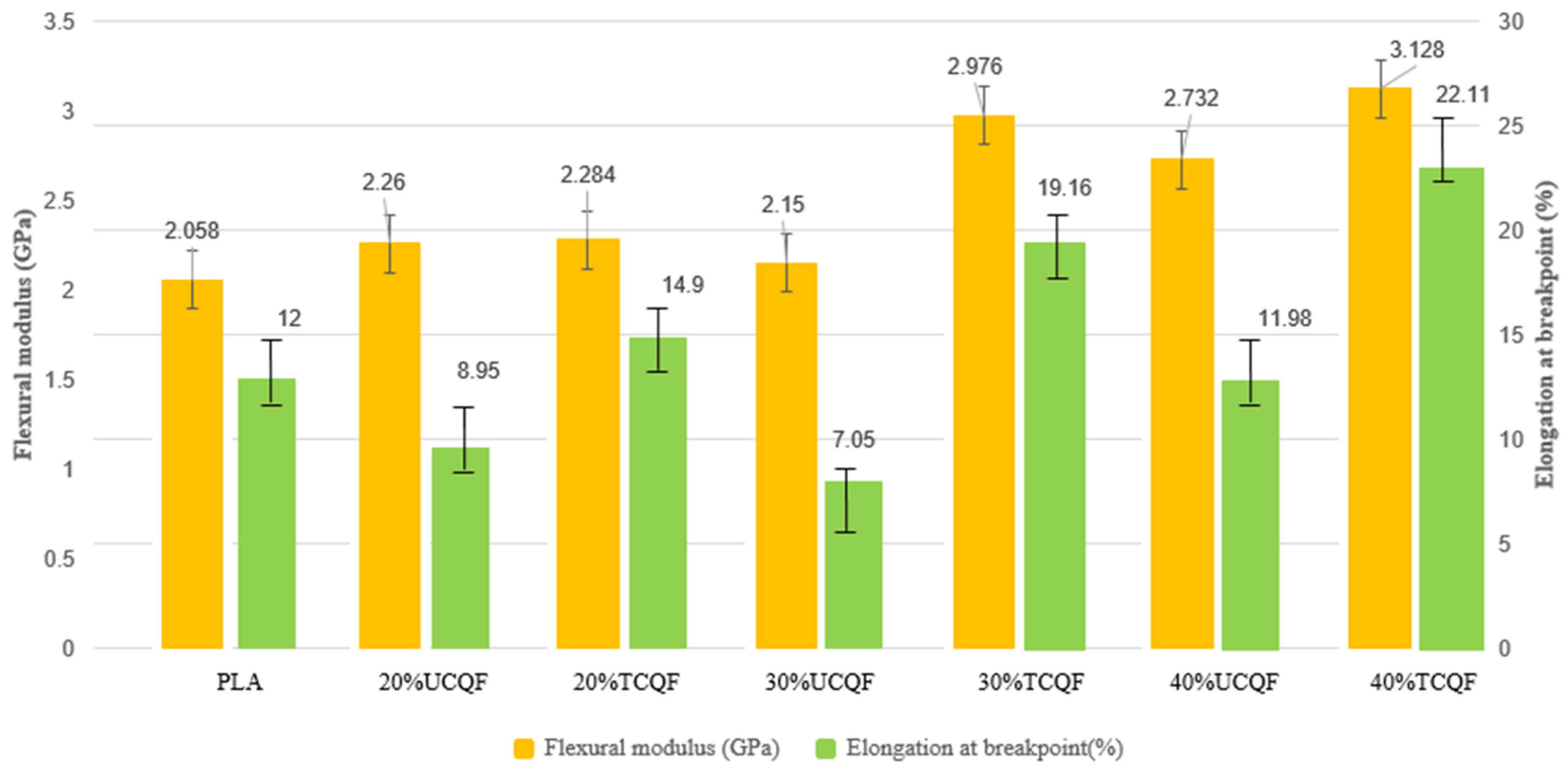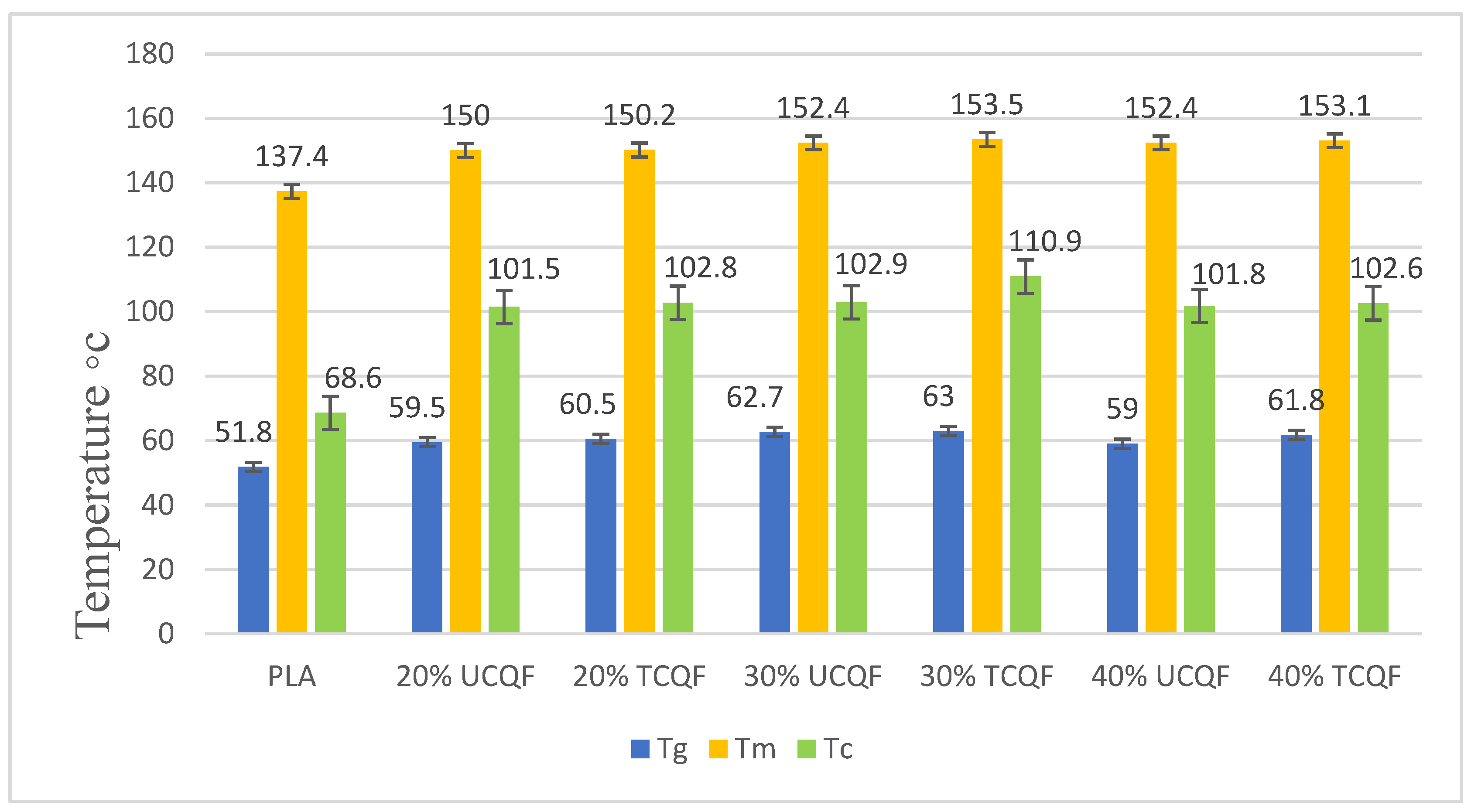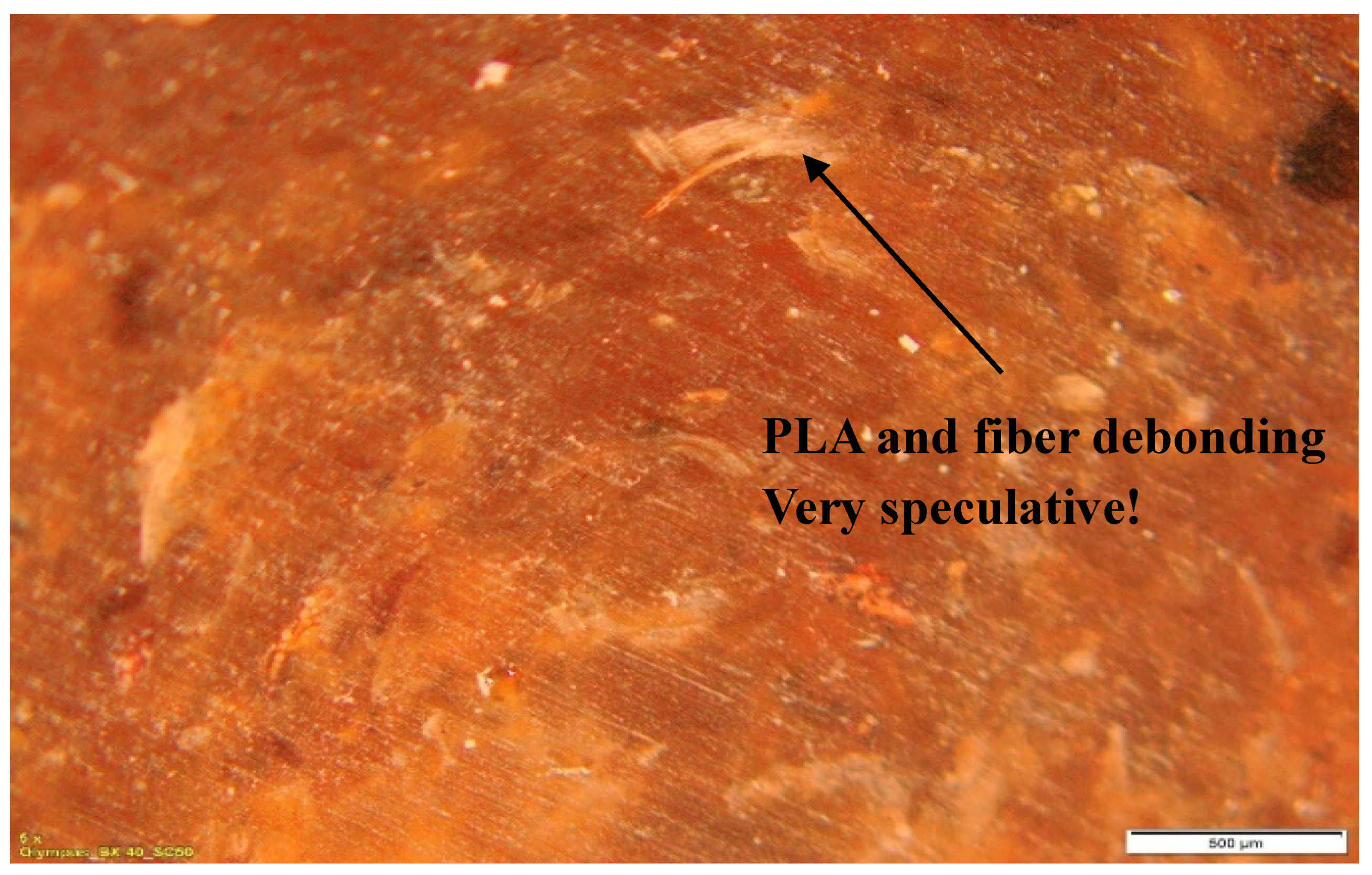Development of “Cissus quadrangularis” Composite Material with Elevated Mechanical Properties and Thermal Stability
Abstract
:1. Introduction
- Wood;
- Seed;
- Leaf;
- Skin/Bast;
- Fruit;
- Stalk.
2. Materials and Methods
2.1. Materials
2.1.1. Cissus quadrangularis Fiber
2.1.2. Matrix Resin
2.1.3. Alkaline Treatment
2.2. Design of Experiment
- ❖
- Sample 1 (20 wt.% of fiber + 80 wt.% of PLA);
- ❖
- Sample 2 (30 wt.% of fiber + 70 wt.% of PLA);
- ❖
- Sample 3 (40 wt.% of fiber + 60 wt.% of PLA).
- ❖
- Sample 4 (20 wt.% of treated fiber + 80 wt.% of PLA);
- ❖
- Sample 5 (30 wt.% of treated fiber + 70 wt.% of PLA);
- ❖
- Sample 6 (40 wt.% of treated fiber + 60 wt.% of PLA).
2.3. Methods and Measurements
2.3.1. Composite Calculation
2.3.2. Chemical Measurements
2.4. Processing
2.5. Mechanical Tests
2.5.1. Tensile Test
2.5.2. Flexural Test
2.5.3. Charpy Impact Test
2.6. Thermal Tests
2.6.1. Differential Scanning Calorimetry (DSC)
2.6.2. Heat Deflection Test (HDT)
2.7. Optical Microscopy Test
3. Results
3.1. Tensile Strength
3.2. Flexural Strength
3.3. Impact Strength
3.4. Differential Scanning Calorimetry (DSC)
3.5. Heat Deflection Temperature (HDT)
3.6. Optical Microscopy Test
4. Discussion of Results
5. Conclusions
Author Contributions
Funding
Data Availability Statement
Acknowledgments
Conflicts of Interest
References
- Siva, R.; Gopinath, G.; Premchand, I.M.; Mathiselvan, G.; Kumar, M.S. Study on morphological and mechanical properties of treated and untreated veldt grape/PLA composite. Mater. Today Proc. 2021, 47, 4906–4910. [Google Scholar] [CrossRef]
- Journal of Advanced Research in Natural Fibers. 2020. Available online: https://fazpublishing.com/arnf/index.php/arnf (accessed on 21 October 2023).
- Bafna, P.S.; Patil, P.H.; Maru, S.K.; Mutha, R.E. Cissus quadrangularis L: A comprehensive multidisciplinary review. J. Ethnopharmacol. 2021, 279, 114355. [Google Scholar] [CrossRef] [PubMed]
- Sundaran, J.; Vasanthi, M.; Kamalapathy, M.; Bupesh, G.; Sahoo, U. A short review on the pharmacological activity of Cissus quadrangularis. Biomed. Inform. 2020, 16, 579. [Google Scholar] [CrossRef]
- Deshmukh, K.; Ahamed, M.B.; Deshmukh, R.R.; Pasha, S.K.; Bhagat, P.R.; Chidambaram, K. 3-Biopolymer composites with high dielectric performance: Interface engineering. In Biopolymer Composites in Electronics; Elsevier: Amsterdam, The Netherlands, 2017. [Google Scholar] [CrossRef]
- Patra, A.K. 16-Novel Varieties of Denim Fabrics; Woodhead Publishing: Sawton, UK, 2015. [Google Scholar] [CrossRef]
- Atnurkar, V.; Schuster, J.; Shaik, Y.P. Increased elongation at breaking point with improved mechanical characteristics in PLA. Open J. Compos. Mater. 2023, 13, 13–28. [Google Scholar]
- Oksman, K.; Skrifvars, M.; Selin, J.F. Natural fibers as reinforcement in polylactic acid composites. Compos. Sci. Technol. 2003, 63, 1317–1324. [Google Scholar] [CrossRef]
- Meinander, K.; Niemi, M.; Hakola, J.S.; Selin, J.F. Polylactides-degradable polymers for fibers and films. In Macromolecular Symposia; Hüthig & Wepf: Basel, Switzerland, 1997; p. 123. [Google Scholar] [CrossRef]
- Spiridon, I.; Leluk, K.; Resmerita, A.M.; Darie, R.N. Evaluation of PLA lignin bioplastic properties before and after accelerated weathering. Compos. Part B Eng. 2015, 69, 342–349. [Google Scholar] [CrossRef]
- Graupner, N.; Herrmann, A.S.; Müssig, J. Natural and man-made cellulose fiber-reinforced PLA composites: An overview about mechanical characteristics and application areas. Compos. Part A Appl. Sci. Manuf. 2009, 40, 810–821. [Google Scholar] [CrossRef]
- Spiridon, I.; Darie, R.N.; Kangas, H. Influence of fiber modifications on PLA/fiber composites. Behavior to accelerated weathering. Compos. Part B Eng. 2016, 92, 19–27. [Google Scholar] [CrossRef]
- Indran, S.; Raj, R.E.; Sreenivasan, V. Characterization of new natural cellulosic fiber from Cissus quadrangularis root. Carbohydr. Polym. 2014, 110, 423–429. [Google Scholar] [CrossRef]
- Anggono, J.; Sugondo, S.; Henrico, S.; Purwaningsih, H. Effect of alkali treatment using Calcium hydroxide and the fiber length on the strength of sugarcane bagasse fibers-polypropylene composites. Appl. Mech. Mater. 2015, 815, 106–110. [Google Scholar] [CrossRef]
- Khalid, M.Y.; Imran, R.; Arif, Z.U.; Akram, N.; Arshad, H.; Al Rashid, A.; Márquez, F.P.G. Developments in chemical treatments, manufacturing techniques and potential applications of Natural-fibers-based bio degradable composites. Coatings 2021, 11, 293. [Google Scholar] [CrossRef]
- Espinach, F.X.; Granda, L.A.; Tarrés, Q.; Duran, J.; Fullana-I-Palmer, P.; Mutjé, P. Mechanical and micromechanical tensile strength of eucalyptus bleached fibers reinforced polyoxymethylene composites. Compos. Part B Eng. 2017, 116, 333–339. [Google Scholar] [CrossRef]
- Hossain, S.I.; Hasan, M.; Hasan, N.; Hassan, A. Effect of chemical treatment on physical, mechanical and thermal properties of ladies finger natural fiber. Adv. Mater. Sci. Eng. 2013, 2013, 824274. [Google Scholar] [CrossRef]
- Mayandi, K.; Rajini, N.; Pitchipoo, P.; Jappes, J.W.; Rajulu, A.V. Properties of untreated and chemically treated Cissus quadrangularis natural fibers and their composites with polyester as the matix. Polym. Compos. 2016, 39, 876–886. [Google Scholar] [CrossRef]
- Beckermann, G.; Pickering, K.; Foreman, N. Evaluation of the mechanical properties of injection moulded hemp fibre reinforced polypropylene composites. Adv. Mater. Res. 2007, 29–30, 303–306. [Google Scholar] [CrossRef]
- Subyakto, S.; Hermiati, E.; Masruchin, N.; Ismadi, I.; Prasetiyo, K.W.; Kusumaningrum, W.B.; Subiyanto, B. Injection molded of bio-micro-composites from natural fibers and polylactic acid. Wood Res. J. 2011, 2, 21–26. [Google Scholar] [CrossRef]
- Siva, R. Comparison of mechanical properties and water absorption test oninjection molding and extrusion—Injection molding thermoplastic hemp fiber composite. Mater. Today Proc. 2021, 47, 4382–4386. [Google Scholar] [CrossRef]
- Shahzad, A. Hemp fiber and its composites—A review. J. Compos. Mater. 2011, 46, 973–986. [Google Scholar] [CrossRef]
- Anuar, H.; Zuraida, A.; Kovacs, J.G.; Tabi, T. Improvement of mechanical properties of injection-molded polylactic acid−kenaf fiber biocomposite. J. Thermoplast. Compos. Mater. 2011, 25, 153–164. [Google Scholar] [CrossRef]
- Łączny, D. Mechanical properties of polylactide matrix composite reinforce with long maize stalk fibers. Adv. Sci. Technol. Res. J. 2022, 16, 104–112. [Google Scholar] [CrossRef]
- A Taborda-Ríos, J.; López-Botello, O.; Zambrano-Robledo, P.; AReyes-Osorio, L.; Garza, C. Mechanical characterization of a bamboo fiber/polylactic acid composite produced by fused deposition modeling. J. Reinf. Plast. Compos. 2020, 39, 932–944. [Google Scholar] [CrossRef]











| Materials | Tensile Strength (MPa) | Flexural Modulus (GPa) | Impact Strength (Kj/m2) | References |
|---|---|---|---|---|
| Cissus quadrangularis Composite (30%fiber + 70%PLA) | 57.2 | 3.12 | 18.69 | |
| Stalk Composite (30%fiber + 70%PLA) | 47.2↓ | 3.01↓ | 12.99↓ | [19] |
| Hemp Composite (30%fiber + 70%PLA) | 32.3↓ | 1.67↓ | 15.1↓ | [20] |
| Jute Composite (30%fiber + 70%PLA) | 47.63↓ | 2.34↓ | 8.56↓ | [21] |
| Sisal Composite (30%fiber + 70%PLA) | 48.18↓ | 4.43↑ | 11.6↓ | [22] |
| Bamboo Composite (30%fiber + 70%PLA) | 43.79↓ | 3.77↑ | 14.5↓ | [23] |
| Flax Composite (30%fiber + 70%PLA) | 55.4↓ | 2.83↓ | 12.7↓ | [24] |
| Kenaf Composite (30%fiber + 70%PLA) | 54.0↓ | 4.0↓ | 13↓ | [25] |
Disclaimer/Publisher’s Note: The statements, opinions and data contained in all publications are solely those of the individual author(s) and contributor(s) and not of MDPI and/or the editor(s). MDPI and/or the editor(s) disclaim responsibility for any injury to people or property resulting from any ideas, methods, instructions or products referred to in the content. |
© 2023 by the authors. Licensee MDPI, Basel, Switzerland. This article is an open access article distributed under the terms and conditions of the Creative Commons Attribution (CC BY) license (https://creativecommons.org/licenses/by/4.0/).
Share and Cite
Gummadavalli, G.; Schuster, J.; Shaik, Y.P. Development of “Cissus quadrangularis” Composite Material with Elevated Mechanical Properties and Thermal Stability. J. Compos. Sci. 2023, 7, 445. https://doi.org/10.3390/jcs7110445
Gummadavalli G, Schuster J, Shaik YP. Development of “Cissus quadrangularis” Composite Material with Elevated Mechanical Properties and Thermal Stability. Journal of Composites Science. 2023; 7(11):445. https://doi.org/10.3390/jcs7110445
Chicago/Turabian StyleGummadavalli, Gopinath, Jens Schuster, and Yousuf Pasha Shaik. 2023. "Development of “Cissus quadrangularis” Composite Material with Elevated Mechanical Properties and Thermal Stability" Journal of Composites Science 7, no. 11: 445. https://doi.org/10.3390/jcs7110445






